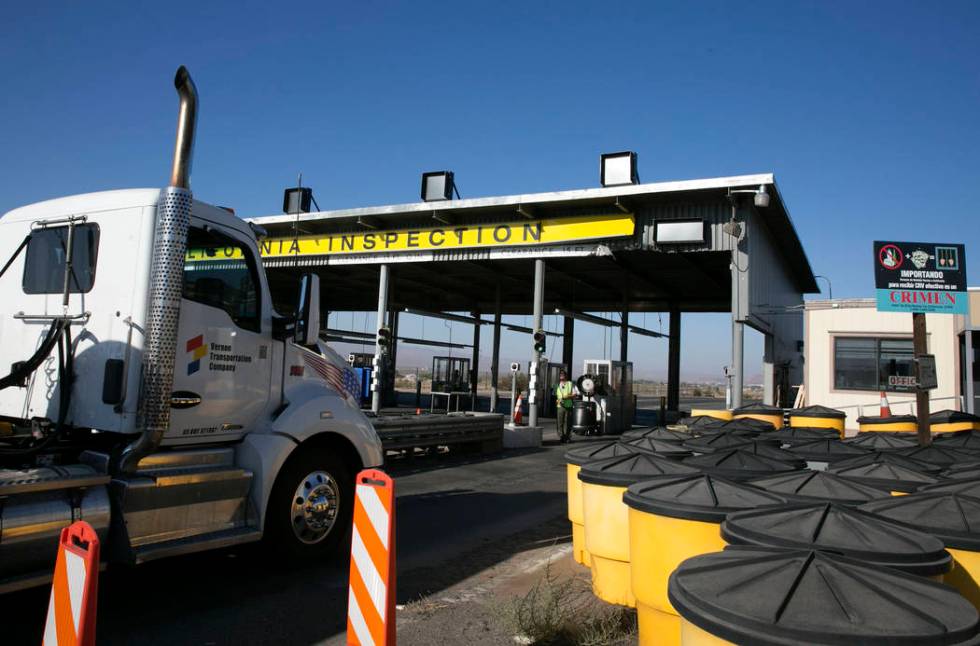LA-bound motorists may soon encounter new inspection station

Drivers speeding into California along southbound Interstate 15 usually come to an abrupt, but necessary, stop about 100 miles past the Nevada border.
And just like that, a state worker usually waves them past a giant, yellow “California Inspection” sign designating the Yermo Border Protection Station.
Big rigs, RVs, livestock haulers and other large vehicles are occasionally pulled aside so that inspectors can determine whether fruit flies, gypsy moths or other potentially dangerous insects are hitching a ride on a vegetable or piece of fruit.
“It’s the first line of defense,” said Steve Lyle, a spokesman for the California Department of Food and Agriculture. “The main role of the stations is to prevent invasive species from entering California, helping the department fulfill its mission to protect the food supply and the environment.”
In the next couple of years, motorists leaving Las Vegas can expect to stop and have their produce checked a whole lot sooner.
Construction could start as soon as fall on a $47 million agricultural inspection station about 7 miles south of the Nevada border, aimed at keeping scofflaws from taking bypass roads to avoid the current facility, Lyle said.
Plus, the old facility, built in 1963, “has become antiquated and is deteriorating,” Lyle said.
An opening date was not disclosed, but the Yermo station’s staff of 22 permanent employees and 10 seasonal workers are expected to be transferred to the new facility.
More than 600,000 vehicles got an up-close physical inspection last year at the Yermo station, Lyle said, with 245 commercial shipments and 637 items from private vehicles rejected for failing to meet California’s stringent standards.
Tired out
Marian from Henderson pointed out that our vehicles take a pretty brutal beating during the summer, and the extreme desert heat can wear down the tires.
AAA Nevada responds to more than 11,000 tire-related calls in Nevada from Memorial Day to Labor Day, making it the most common request for help during the summer.
“In severe climates, like Nevada, it’s difficult for tires to bounce back from the relentless heat,” AAA Nevada spokeswoman Michelle Donati said.
Proper inflation is key to maintaining your tires, Donati said. Checking the tire pressure monthly could help extend the life of your tires by preventing worn-down tread or a blowout.
Most Nevada drivers will wear out a set of tires within four years, Donati said. At most, Nevadans should replace their tires every five years, regardless of tread life or miles driven.
Cracks are getting sealed
Don from Henderson said that a private company hired by the city recently filled some cracks and resealed the pavement in his Green Valley neighborhood, but not all of the spaces were filled. He wanted to know whether the city’s taxpayers are getting ripped off for incomplete work.
Not all cracks are treated the same way, Henderson city spokeswoman Kim Becker said. The city uses a rating system to rank maintenance needs as a way to stretch the city’s money.
Cracks smaller than a quarter-inch will be covered after a seal coat or slurry treatment is placed over them, Becker said. Cracks larger than a half-inch are big enough for the seal coat or slurry to be applied. Cracks that fall somewhere in between are sealed before applying slurry.
“So, we’re taking care of the tracks in the most economical and efficient way we can,” Becker said. “The contractor is indeed doing their job.”
Unfinished road striping
With a lot of houses springing up in the southwest end of the valley, Dave from Las Vegas noticed that developers are building roads without reflective markers to designate lane separations — particularly in his neighborhood near Fort Apache Road, between Blue Diamond Road and Tropicana Avenue.
This is done intentionally. The developers are generally asked to leave the roads alone for the sake of continuity or until a complete section is paved, Clark County spokesman Dan Kulin said.
As an example, Kulin said that the county has plans to improve Fort Apache between Warm Springs Road and Tropicana sometime next year, with plans to pave and stripe any sections that were not completed by housing developers.
In the meantime, county officials will inspect the existing road markings on Fort Apache between Warm Springs and Blue Diamond, Kulin said.
Work on Eastern
A couple of readers have asked recently about the road work along Eastern Avenue, between Warm Springs Road and Wigwam Avenue.
Eastern is being rebuilt along that stretch of road as part of a larger improvement project leading to the 215 Beltway, Kulin said. New pavement will be added in the next few weeks.
Questions and comments should be sent to roadwarrior@reviewjournal.com. Please include your phone number. Follow @RJroadwarrior on Twitter.